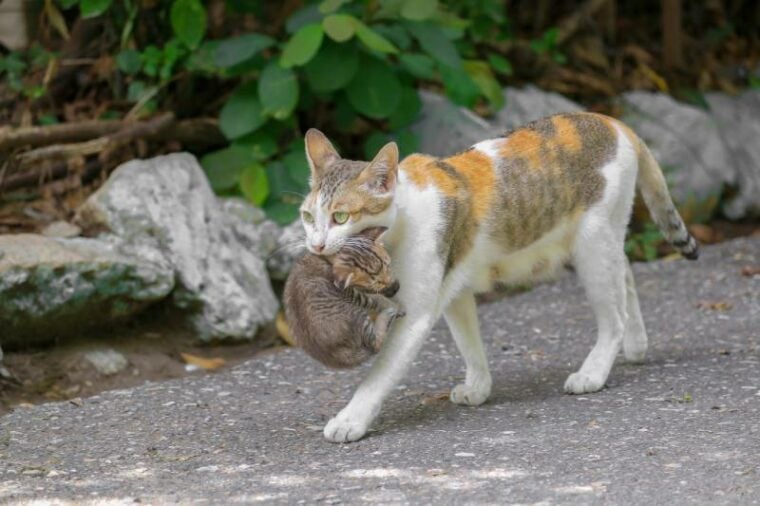
Cats are among the most maternal animals, with their parental instincts kicking in as soon as they give birth. One of the first things a new mother cat will do is carry her kittens around to ensure that they’re safe and secure. But how exactly do cats carry their kittens? By the scruff of their necks! Here, we’ll explore why cats carry kittens this way and why a mother cat might be carrying her kittens in the first place.
How Cats Carry Kittens
The most common way for a cat to transport her kittens is by picking them with their teeth and carrying them in her mouth. Cats can’t carry things the way that people can, so this is the only way to move a kitten. This method of transportation might seem uncomfortable for the small creatures, but it actually ensures that the kittens stay warm and snug against their mother’s body heat, and it doesn’t hurt the kitten.
That’s because kittens have a patch of skin on the back of their necks called a scruff. The cat grabs the kitten by the scruff if she needs to move it around or carry it somewhere else. A cat knows how to do this instinctually. Although it shouldn’t hurt the kitten, a first-time cat mother may pick up and put down the kitten a few times when trying to move it until she grabs the right spot on the kitten’s neck. Most kittens are comfortable with their mothers doing this, but they may squirm or mew at first since they’re still learning.
As a kitten ages and learns to walk, the mother cat will “encourage” their kittens to walk alongside them as they travel. The mother cat can use her paw or tail to gently lead the kittens in the right direction and provide any necessary guidance along the way. This method allows for maximum freedom of movement while also providing a sense of security and protection, which is especially important when traveling through unfamiliar areas.
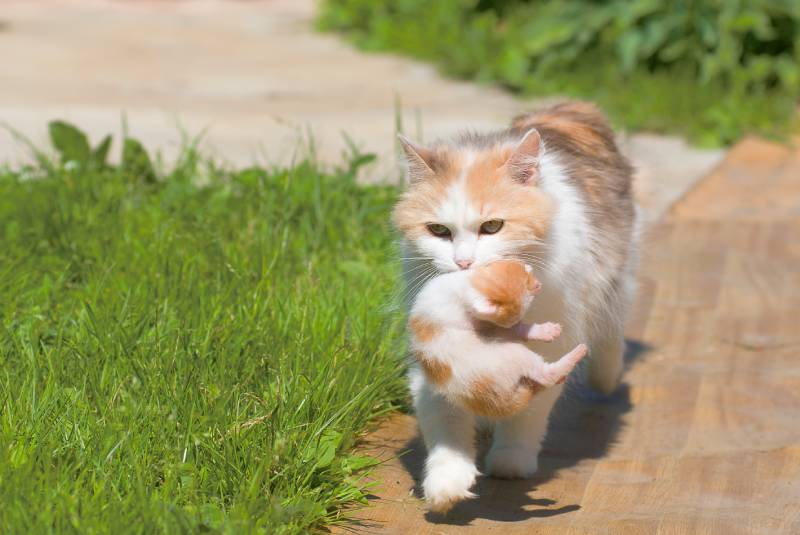
Why Cats Move Their Kittens
Cats move their kittens for a number of reasons. In most cases, cats will transport their babies when they need to be relocated to a new or safer area. This could be done if the mother cat is looking for food or shelter, if there are predators in the vicinity, or if she needs to find a new place to raise her young.
It is important for cats to be able to transport their kittens safely and securely, as it ensures that the babies will remain unscathed during the journey. This is especially important for newborn kittens, who are too young and fragile to venture out on their own and rely solely on their mother’s protection.
Cats are unable to fit all of their kittens inside their mouth at once and must carry them one by one to the new location. So, not only is carrying them by the scruff of the neck the only way a cat can move kittens, but it’s also the fastest. No matter the reason why kittens are being moved, it’s clear that cats have developed a practical way of safely transporting their babies from one place to another.
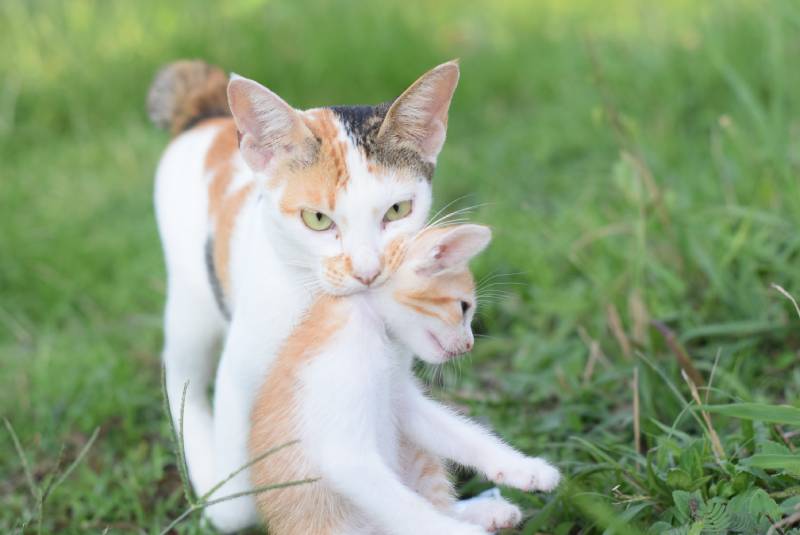
Should I Help My Cat Move Her Kittens?
In most cases, it is best to let cats take care of their own kittens and not interfere with the process. Cats are able to instinctively determine what’s best for their young and it’s important to give them the space they need to make sure that their babies are safe and secure. If you feel that your cat is struggling or in danger, then you should intervene and provide help if necessary. Ultimately, though, cats know how to provide the best care for their young and it’s important to trust in their instincts when they are moving kittens from one place to another.
What Is the Perfect Place for a Cat to Have Her Kittens?
If your cat is pregnant and you’re concerned about her having to move her kittens because she didn’t give birth in a safe place, you may be wondering what the best place is for a cat to have kittens. The perfect place for a cat to have her kittens is wherever she feels the most secure and comfortable. This could be in a nest of blankets or other soft materials, under a bed or in any small space that provides relative safety from predators and other dangers.
In addition, it’s important that the mother cat has access to food and water while caring for her babies, so an area near available resources is ideal. Ultimately, all cats are different and will choose what works best for them when it comes to raising their young. So usually, you don’t have to intervene in this process other than providing the mother with everything she needs as far as food, water, and shelter.
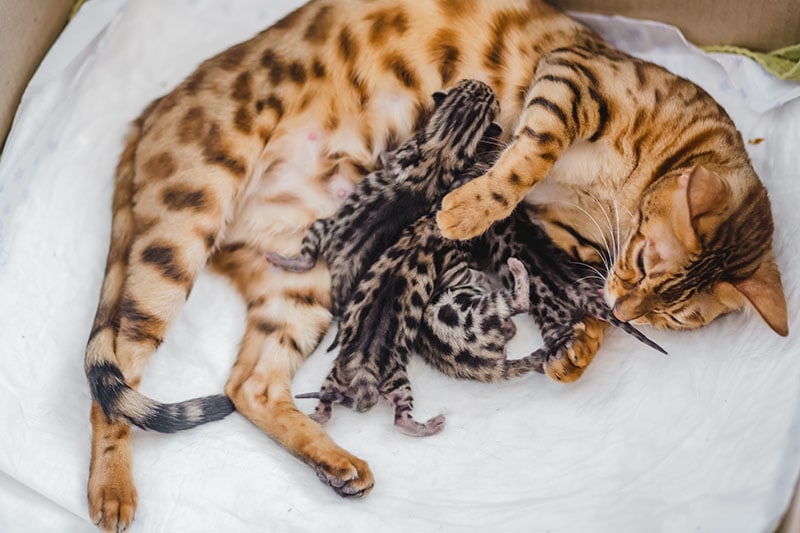
Tips for Creating a Safe Birthing Space for Your Cat, Indoor and Outdoor
Every cat has different needs. Some cats may prefer to give birth in a quiet corner while others might be more comfortable birthing outdoors. Here are 10 tips to help create a safe and secure space for your cat, whether they’re indoors or outside:
- Ensure that the birthing space is in a quiet and undisturbed area.
- Provide a soft surface for your cat to lay on, like blankets or towels.
- Place food and water dishes nearby so your cat has easy access to them while caring for her kittens.
- Check the temperature of the room regularly, as it should remain at an even level to prevent any discomfort during delivery.
- Keep predators away by closing off entrances or covering windows with curtains or screens if necessary.
- Remove any dangerous objects from the birthing space that could harm your cat or her kittens when they are born, such as sharp edges or potential choking hazards like threads and strings.
- Place the litter box close to where your cat will be giving birth, so that she can easily access it when necessary.
- Make sure there is enough space for your cat to move around while caring for her kittens.
- Line the birthing area with materials like newspaper or absorbent pads that can easily be cleaned and replaced if needed.
- Above all else, provide a sense of security and protection in the birthing space, as this is especially important when cats are raising their young in unfamiliar areas.
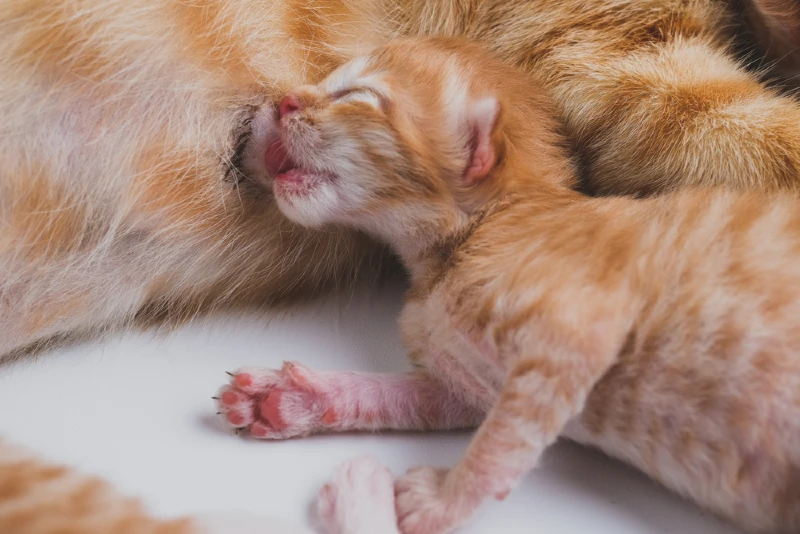
 Conclusion
Conclusion
Cats have developed a unique way to transport their kittens from one place to another, ensuring that they stay safe and secure while also allowing them the freedom to explore new areas. Cats can be trusted to make the best decisions when it comes to caring for their babies, so it’s important not to interfere unless absolutely necessary. With their innate motherly instincts, cats are able to provide all of the protection and support that their young need when traveling from one place to another.
See Also:
- How Does a Mother Cat Discipline Her Kittens? 4 Different Ways
- Why Does My Cat Keep Moving Her Kittens? 8 Vet Reviewed Reasons
Featured Image Credit: Mr.Sutun photographer, Shutterstock






